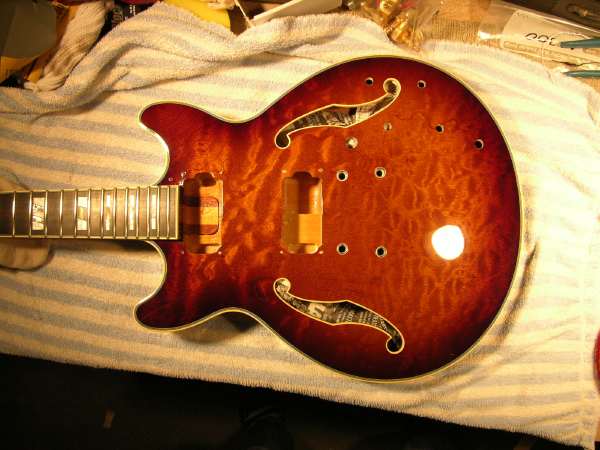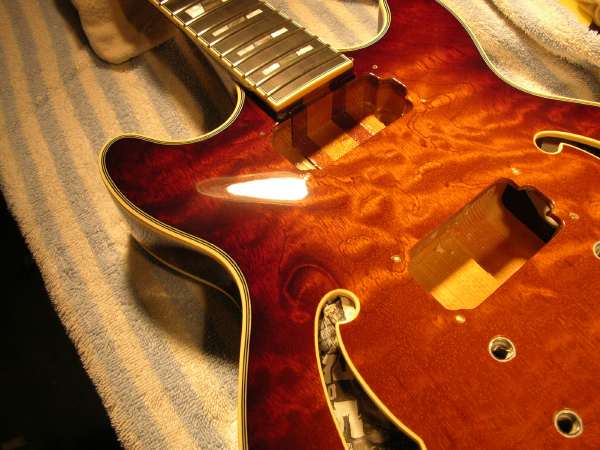|
| Author |
Message |
    
Funkle
Username: Funkle
Registered: 12-2001
| | Posted on Monday, June 20, 2005 - 12:35 pm: | |
I've noticed that on some older Ibanez guitars, the clear finish will sink into the pores of the wood, resulting in an uneven finish that shows the grain contours of the wood. But in other cases, the finish is as smooth as glass. Any ideas of why this would or would not happen? variation in finish thickness, finish type, or grain filler? I know that in one case, the guitar lived most of it's life in a very hot dry climate. Could the finish have become dried out? Is it a bad idea to rub out a guitar that has a shrunken finish like this?

 |
    
Boymambo
Username: Boymambo
Registered: 05-2005
| | Posted on Tuesday, June 21, 2005 - 7:53 am: | |
This may or may not help, but I have two thoughts on this. With pre-1989(?) PRS guitars the finish that was applied was very heavily thinned out, that is they used a lot of thinner and they had a similar issue. I have an 86 finished PRS and the finish has sunk in to the guitar as well. It may be the same for Ibanez. Secondly, a nitro cellulose finish takes a very long time to harden, more than six months, so the sink could be part of that process. Hope this helps. |
    
Funkle
Username: Funkle
Registered: 12-2001
| | Posted on Tuesday, June 21, 2005 - 4:03 pm: | |
Thanks Mambo.
As far as I know, Ibanez, and most other large scale manufacturers have used primarily poly finishes for quite a while. I doubt these are nitro. They are a '90 AM200 and an '81 AR100.
-Sven |
    
Ibanezfreak1960
Username: Ibanezfreak1960
Registered: 03-2004
| | Posted on Wednesday, June 22, 2005 - 12:37 pm: | |
It looks to me as if the surface was not smooth to start from. Also not properly sanded between coats to smoothe and fill in the grain.
Spiro could tell you what it is for sure! |
    
Spiro
Username: Spiro
Registered: 02-2001
| | Posted on Wednesday, June 22, 2005 - 4:45 pm: | |
Hey everyone..
The reasons the finish starts to sink into the woodgrain is as follows (Or at Least what I have read and been told)
1. The finish is losing some of its moisture and starts to shrink just as rubber shrinks and hardens.
2 the grain filler is starting to dry out and then the finish sinks into the the wood grain..
I have seen this happens to guitars which are less than 10 years old.. and then there are guitars that this does not happen to at all. when it comes to poly finishes my thought is that there was an imbalance of finish and hardener so the finish after all these years is still hardenening.. In nitro finishes this is to be expected (thats what gives nitro guitars their character i think)
I personally like it on a transparent finish, but on a black guitar it looks horrible.
On solid finishes I think that what has happend is the filler coats were not given enough time to dry out before they were finish sanded and then the colour coat applied so the finish is sinkng along with the filler coats.. (these filler coats can be applied quite heavily especially on japanese and korean guitars..
I have actually refinished guitars and purposely wanted his to happen but that is not normally the case..
When I finish a sold colour guitar I do the the following.
I apply the the sealer coats.(about 4-6 heavy coats) then leave the item to dry for at least a week..
I then sand and reapply filler where required, and then let dry for another week... After the week i check and make sure i cannot smell absolutely any solvent in the item.. I f i ca still smel the solvent i leave it for another week.
Once I think it has dried enough I then sand the finish smooth with 400 (and a plasterers sanding stick or even a panel beaters sanding stick, Very similar) and the finish off with 600..
I then apply at least 3 or 4 colur coats and then let dry for another week or 2.
I then check the finish to see if it has sunk into the guitar if it hasnt I start applying clear coats (possibly up 12 coats.) I will only apply 2 coats per day 1 in the morning and 1 in the afternoon (approx 4-5 hours apart..)
After this has finished i will leave the item for 4-6 weeks to dry. Then buff and and reassemble..
This process is very time consuming I know (that is why they charge more for solid finishes) But the end result is an item with an extremely smooth finish.
But it will sink eventually!!! |
    
Funkle
Username: Funkle
Registered: 12-2001
| | Posted on Wednesday, June 22, 2005 - 5:51 pm: | |
Thanks Spiro!
So would you not recommend rubbing out the finish when it has sunken like this? The finish on the AM looks tired and I'd like to give it a little shine. I will use a foam pad in a drill to apply medium cut compound, then follow with swirl remover, polish and wax. I'll go pretty light and gentle with the compound. Maybe I'll try a finer cut. I'd just HATE to rub through the finish on this one!
-Sven |
    
Funkle
Username: Funkle
Registered: 12-2001
| | Posted on Wednesday, June 22, 2005 - 5:52 pm: | |
BTW Spiro, are you shooting nitro or poly?
-Sven |
    
Spiro
Username: Spiro
Registered: 02-2001
| | Posted on Wednesday, June 22, 2005 - 6:00 pm: | |
No worries sven..
I would try and buff out the finish by hand actually sven.. I would use a Meguires scratch X compound and then deep crystal all by hand and finally finish off with your choice of swirl remover..
BTW I am shooting Nitro.. |
    
Jerryneves
Username: Jerryneves
Registered: 03-2001
| | Posted on Tuesday, June 28, 2005 - 11:50 am: | |
There is enough finish on those guitars to wet sand the finish flat with 1500 or 2000. Then it will polish out perfectly and shouldnt shrink again. I did my AM205 and 79 AS200 and they still look brand new. I noticed that the Mahogany and Ash guitars do it the worst and thats because they have the more porous and or heavier grains. If you dont feel comortable doing it yourself a shop would be able to do it in a little over an hour if they use a machine to buff it. If you have little or no experience with a buffer then you should do it by hand. Thats going to take some time and in that case I wouldnt sand with anything heavier than 2000.
Jerry |
    
Funkle
Username: Funkle
Registered: 12-2001
| | Posted on Wednesday, June 29, 2005 - 12:46 pm: | |
Thanks Jerry,
Maybe you could take a look at my AM200 and give me your opinion. Drop me an email. I emailed you a while back, but I don't think it got to you.
-Sven |
    
Funkle
Username: Funkle
Registered: 12-2001
| | Posted on Monday, July 04, 2005 - 6:29 pm: | |
Well, I followed Jerry and Spiro's advice and sanded down the finish on my AM200. It took about 4 hours total, 6 steps in total. The finish looks like great, like poured on liquid now, and the wood figuring looks much deeper.


Can't wait to play her. I'm still waiting on a few parts. |
    
Johns
Username: Johns
Registered: 02-2001
| | Posted on Tuesday, July 05, 2005 - 9:07 am: | |
Sven:
Looks great! Sounds (and looks) like a lot of work. But from the looks of the sheen, it's well worth it.
See anything interesting about the construction of this puppy, while you have all the guts out of it? |
    
Funkle
Username: Funkle
Registered: 12-2001
| | Posted on Tuesday, July 05, 2005 - 10:34 am: | |
Yes, as a matter of fact. This was going to be the subject of another post. There are 2 things I noticed:
The neck joint is not very tight, there is a fairly large gap running all the way around as you can see in the neck PU cavity. This may be common practice, but I've never seen it before. It seems like a tight fit would be better in terms of tone and strength.
The center block appears to be pine. Or perhaps spruce, ash or some other wood? I hate to think FujiGen would use a 2x4 in the construction of a high end guitar, but it does appear to be a softwood. Actually, the center block is a lamination consisting of what looks like 1/4 " of mahogany on top, 2 1/2" stips of maple on either side of the hunk of lumber in the center. The top is a 5 ply lamination that looks like a thin layer of mahogany, a thick layer of spruce, a thin layer of something dark, a thick layer of mahogany, another thin layer of dark wood.
-Sven |
    
Funkle
Username: Funkle
Registered: 12-2001
| | Posted on Wednesday, July 13, 2005 - 1:34 pm: | |
Bump: Anybody have any thoughts on this? |
|
|
Thank you for supporting Ibanez Collectors Forum. Please help your favorite Ibanez guitar site as we endeavor to bring you the latest information about Ibanez custom vintage electric and acoustic guitars. Here you can discuss ibanez, guitars, basses, acoustics, acoustic, mandolins, electric guitar, electric bass, amplifiers, effect pedals, tuners, picks, pickups.
|



